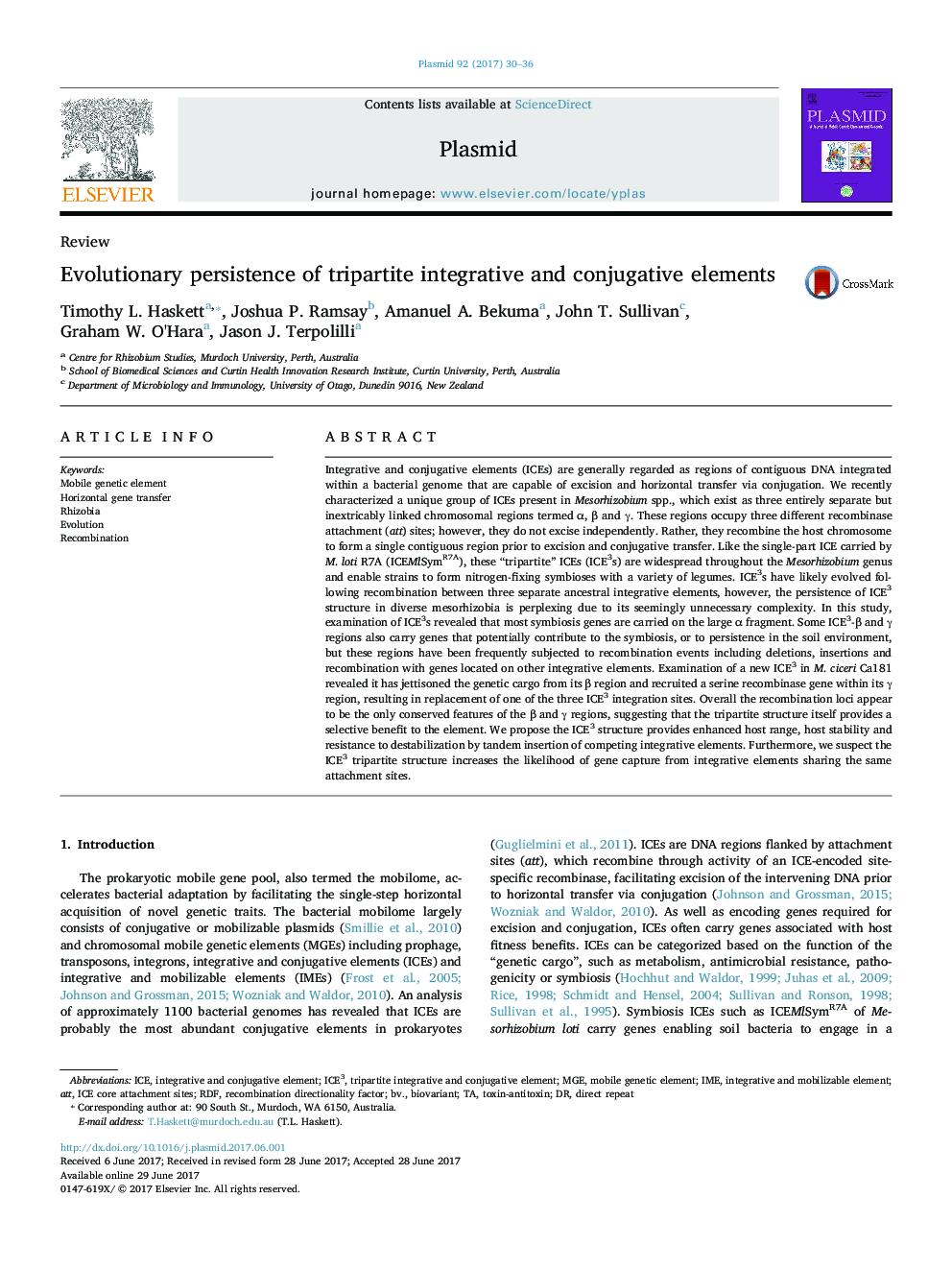| کد مقاله | کد نشریه | سال انتشار | مقاله انگلیسی | نسخه تمام متن |
|---|---|---|---|---|
| 5591022 | 1570331 | 2017 | 7 صفحه PDF | دانلود رایگان |
عنوان انگلیسی مقاله ISI
Evolutionary persistence of tripartite integrative and conjugative elements
ترجمه فارسی عنوان
پایداری تکاملی عناصر یکپارچه و سهبعدی سه جانبه
دانلود مقاله + سفارش ترجمه
دانلود مقاله ISI انگلیسی
رایگان برای ایرانیان
کلمات کلیدی
RDFMGEIME - NAMEHorizontal gene transfer - انتقال ژن افقیATT - بهToxin-antitoxin - توکسین-آنتی تکسینdirect repeat - تکرار مستقیمRecombination - دوباره سازیRhizobia - ریزبویاMobile genetic element - عنصر ژنتیک تلفن همراهIntegrative and conjugative element - عنصر یکپارچه و همگراEvolution - فرگشت Ice - یخ
موضوعات مرتبط
علوم زیستی و بیوفناوری
بیوشیمی، ژنتیک و زیست شناسی مولکولی
ژنتیک
چکیده انگلیسی
Integrative and conjugative elements (ICEs) are generally regarded as regions of contiguous DNA integrated within a bacterial genome that are capable of excision and horizontal transfer via conjugation. We recently characterized a unique group of ICEs present in Mesorhizobium spp., which exist as three entirely separate but inextricably linked chromosomal regions termed α, β and γ. These regions occupy three different recombinase attachment (att) sites; however, they do not excise independently. Rather, they recombine the host chromosome to form a single contiguous region prior to excision and conjugative transfer. Like the single-part ICE carried by M. loti R7A (ICEMlSymR7A), these “tripartite” ICEs (ICE3s) are widespread throughout the Mesorhizobium genus and enable strains to form nitrogen-fixing symbioses with a variety of legumes. ICE3s have likely evolved following recombination between three separate ancestral integrative elements, however, the persistence of ICE3 structure in diverse mesorhizobia is perplexing due to its seemingly unnecessary complexity. In this study, examination of ICE3s revealed that most symbiosis genes are carried on the large α fragment. Some ICE3-β and γ regions also carry genes that potentially contribute to the symbiosis, or to persistence in the soil environment, but these regions have been frequently subjected to recombination events including deletions, insertions and recombination with genes located on other integrative elements. Examination of a new ICE3 in M. ciceri Ca181 revealed it has jettisoned the genetic cargo from its β region and recruited a serine recombinase gene within its γ region, resulting in replacement of one of the three ICE3 integration sites. Overall the recombination loci appear to be the only conserved features of the β and γ regions, suggesting that the tripartite structure itself provides a selective benefit to the element. We propose the ICE3 structure provides enhanced host range, host stability and resistance to destabilization by tandem insertion of competing integrative elements. Furthermore, we suspect the ICE3 tripartite structure increases the likelihood of gene capture from integrative elements sharing the same attachment sites.
ناشر
Database: Elsevier - ScienceDirect (ساینس دایرکت)
Journal: Plasmid - Volume 92, July 2017, Pages 30-36
Journal: Plasmid - Volume 92, July 2017, Pages 30-36
نویسندگان
Timothy L. Haskett, Joshua P. Ramsay, Amanuel A. Bekuma, John T. Sullivan, Graham W. O'Hara, Jason J. Terpolilli,
